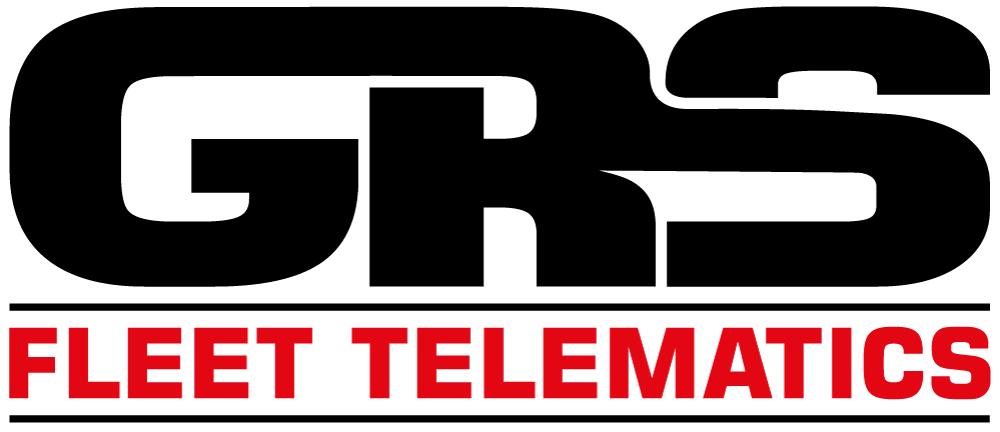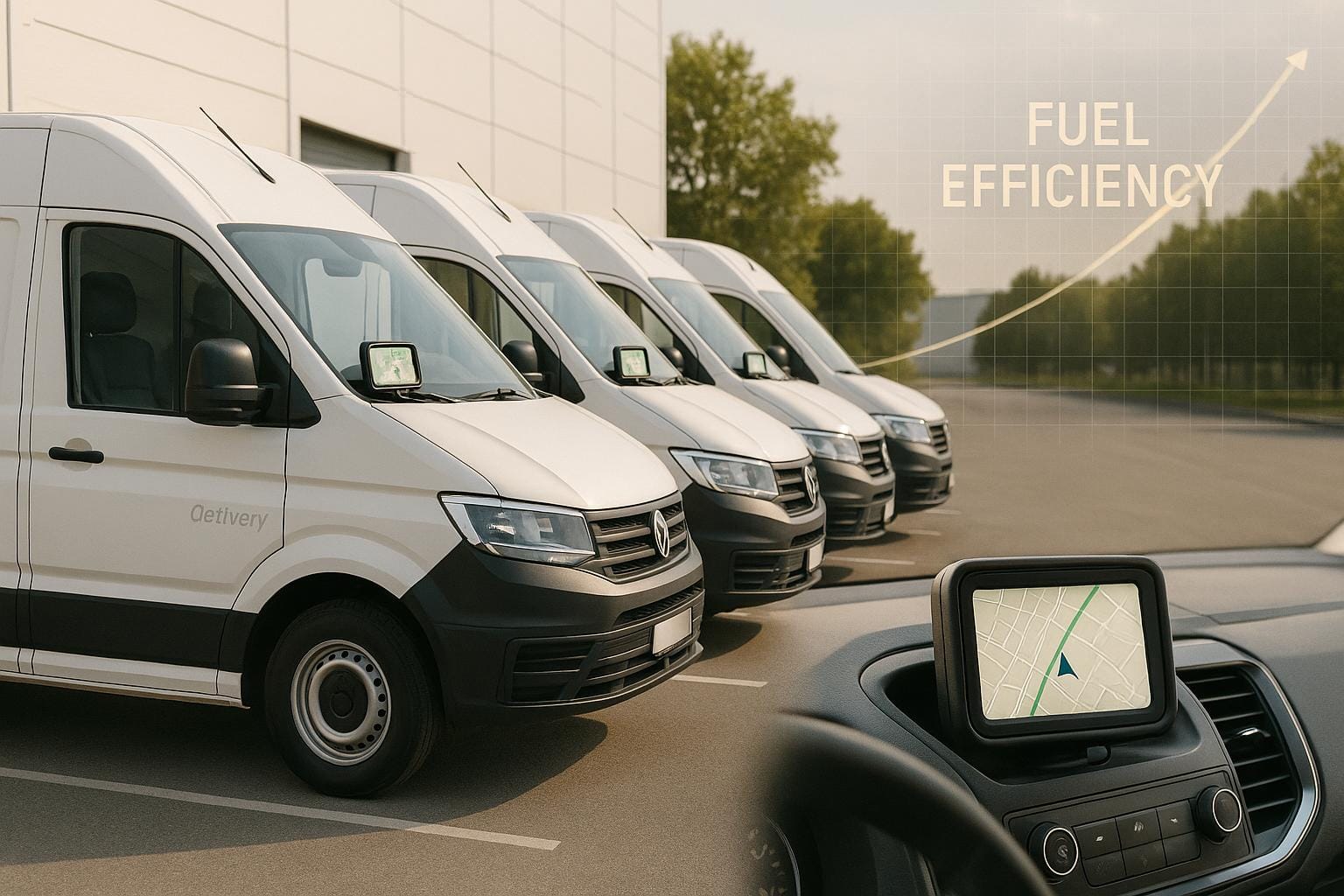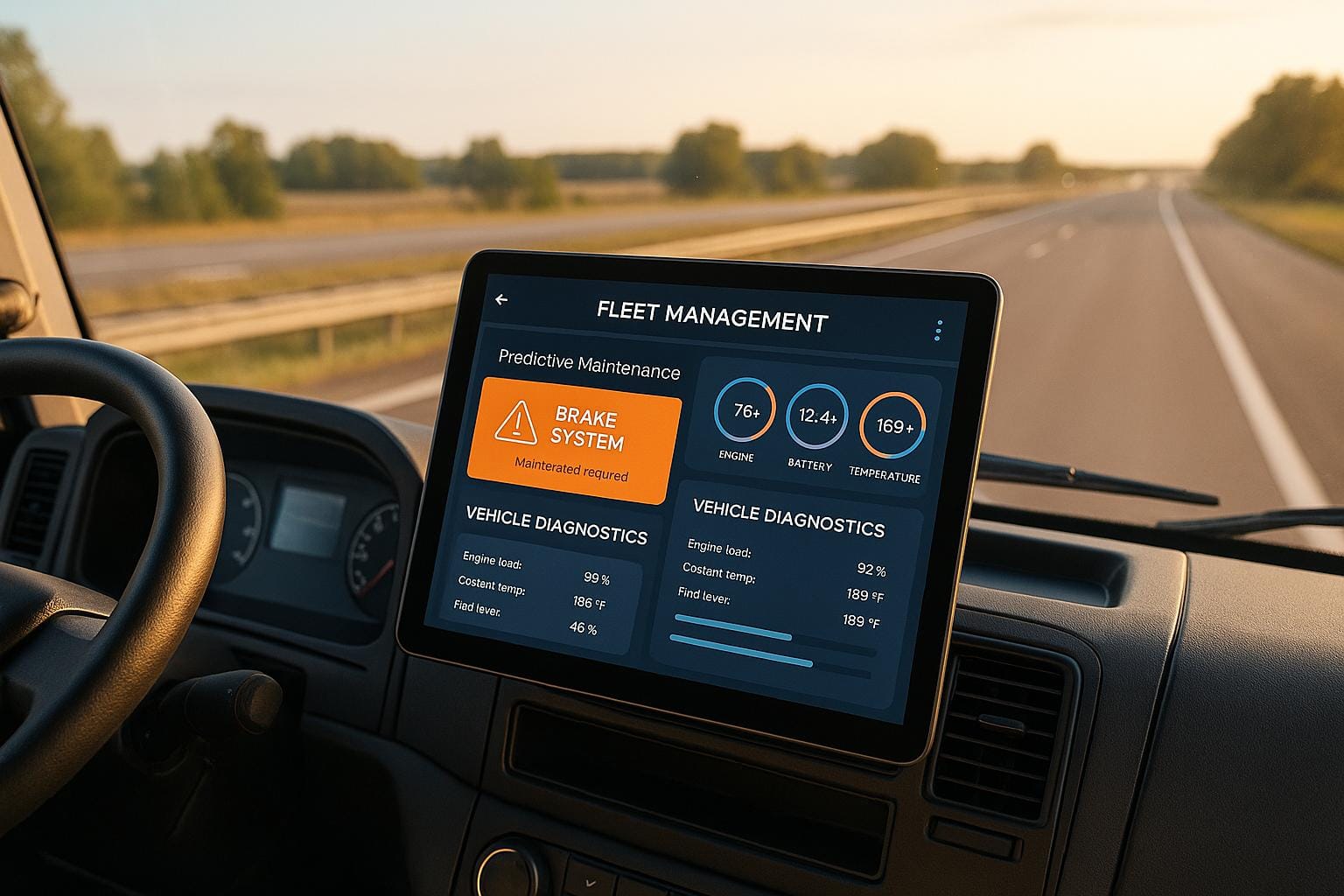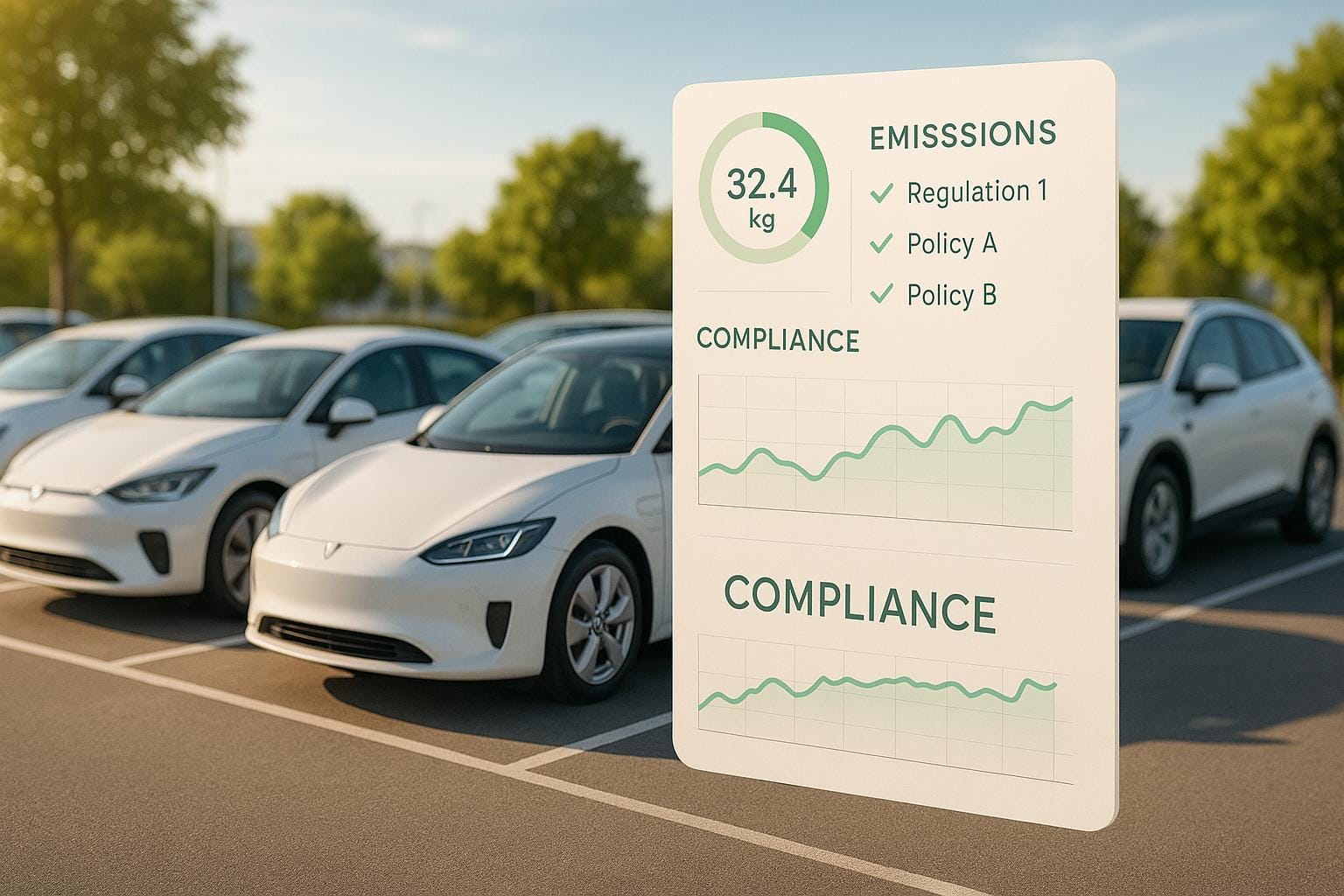Fleet tracking systems help businesses save fuel, reduce costs, and lower emissions. Here's how:
- Save Up to 20% on Fuel Costs: Monitor driver behaviour, reduce idling, and optimise routes to cut fuel use.
- Real-Time Tracking: Spot inefficiencies like harsh braking or speeding instantly.
- Prevent Fuel Theft: Detect unusual fuel usage patterns and secure your fleet.
- Meet UK Emissions Goals: Track and report CO₂ reductions to comply with regulations.
- Affordable Solutions: Start from just £7.99/month with providers like GRS Fleet Telematics.
Fleet tracking doesn’t just reduce fuel expenses - it also helps businesses achieve sustainability goals and comply with UK regulations.
Keep reading to learn how telematics transforms fleet management.
How Does A Fleet Management App Improve Fuel Efficiency? - Talking Tech Trends
Key Fleet Tracking Features That Reduce Fuel Consumption
Modern fleet tracking systems leverage GPS and telematics to track fuel usage patterns in real time. By collecting and analysing data from various sources, these systems help fleet managers identify inefficiencies and take targeted action to improve fuel economy. Let’s explore the core features that make this possible.
Real-Time Vehicle Monitoring and Data Collection
Real-time monitoring is at the heart of effective fuel management. Fleet tracking systems use GPS and onboard diagnostics to gather key data, such as vehicle location, fuel consumption, driver behaviour, and maintenance needs. This live data provides actionable insights into inefficiencies that can be addressed immediately.
For example, real-time alerts flag issues like excessive idling, erratic speed changes, and harsh braking - each of which can increase fuel consumption by up to 20%. Long-haul drivers, for instance, may idle their vehicles for six to eight hours daily over 300 days a year, leading to significant fuel waste. Similarly, inconsistent speeds can cause a truck to burn 20% more fuel.
Maintenance monitoring is another critical function. Continuous checks can detect issues like low tyre pressure, which reduces fuel efficiency by 0.2% for every one psi drop. Alerts notify managers when maintenance is needed, helping to prevent minor problems from escalating into costly fuel drains.
The benefits of real-time monitoring are clear. According to the 2024 Verizon Connect Fleet Technology Trends Report, fleets using GPS tracking systems reduced their fuel costs by an average of 9%. This reduction is directly linked to the ability to spot and resolve inefficiencies as they occur.
Fuel Consumption Analysis and Reporting
While real-time monitoring tackles immediate issues, automated reporting provides a broader view of fuel-saving opportunities. Fleet tracking systems generate detailed reports that highlight consumption patterns, trends, and anomalies across the fleet. These insights enable managers to shift from reactive fixes to proactive strategies.
Reports can pinpoint specific vehicles or drivers with unusually high fuel usage, helping managers identify whether the problem lies with mechanical issues, inefficient routes, or driver habits. This level of detail allows for targeted solutions rather than blanket changes that might not address the root causes.
Idle time reporting is particularly valuable. These reports identify vehicles that idle excessively, revealing opportunities for immediate savings. Since restarting a vehicle uses less fuel than idling for 30 seconds, such data can guide the development of policies and training programmes. Over a month, vehicles with excessive idling can consume 15% to 30% more fuel, making this insight crucial for cost reduction.
Fuel theft detection is another key feature of reporting systems. Alerts triggered by sudden drops in fuel levels or unusual consumption patterns can help prevent unauthorised usage.
The financial impact of these reporting tools is significant. They quantify savings across fuel, maintenance, and operations, providing clear evidence of the value of telematics.
| Fleet Size | Average Monthly Fuel Savings | Maintenance Savings | Combined Savings |
|---|---|---|---|
| 10 Vehicles | £600–£900 | £225–£375 | £825–£1,275 |
| 50 Vehicles | £3,000–£4,500 | £1,125–£1,500 | £4,125–£6,000 |
| 100+ Vehicles | £6,000–£9,000 | £2,250–£3,000 | £8,250–£12,000 |
Route Planning to Cut Fuel Waste
Efficient route planning is a game-changer when it comes to reducing fuel consumption for fleet operations. By leveraging algorithms and real-time data, modern fleet tracking systems create optimised routes that minimise unnecessary mileage and avoid traffic hotspots. The result? Fuel costs can drop by as much as 20%.
Today's telematics systems go beyond basic route planning. They take into account factors like traffic patterns, road conditions, weather, and driver availability. This ensures vehicles follow the most fuel-efficient routes while still meeting delivery deadlines. Let’s dive into how dynamic updates and integrated mapping make these systems even more effective.
Dynamic Route Planning with Live Traffic Updates
Dynamic route planning takes efficiency to the next level by continuously adapting to on-road conditions. Unlike traditional static routes, this technology reacts in real time to traffic congestion, accidents, or unexpected detours. For example, if a road is suddenly closed or traffic begins to pile up, the system instantly reroutes vehicles, helping drivers avoid fuel-wasting stop-and-go traffic.
This approach is particularly useful in bustling urban areas where conditions can change rapidly. Avoiding heavy congestion in these environments can lead to noticeable fuel savings. Additionally, the system considers adverse weather conditions, adjusting routes to maintain consistent fuel performance even when external factors are less than ideal.
Integration with Mapping Solutions
Advanced fleet tracking systems also integrate with specialised mapping tools for more precise route planning. For instance, GRS Fleet Telematics utilises detailed mapping data, such as Ordnance Survey maps, to ensure routes are tailored to specific vehicle types. This is especially crucial for HGVs, where factors like weight limits and low clearances come into play.
These integrated maps help identify routes that avoid restrictions, ensuring both compliance and efficiency. They also account for elevation changes, balancing distance against gradients to find the most fuel-efficient path - an important feature for vehicles carrying heavy loads.
Moreover, integration with client systems allows for seamless synchronisation of scheduling and routing, cutting out unnecessary trips. Regular route analysis further enhances these systems, helping fleet managers spot trends and make ongoing refinements to maximise fuel savings over time. This combination of precise mapping and real-time monitoring creates a powerful strategy for reducing fuel waste.
Driver Behaviour Monitoring for Better Fuel Economy
How a driver handles a vehicle can greatly influence fuel consumption, and telematics systems provide fleet managers with the tools to monitor and improve these habits. Aggressive driving, for instance, can increase fuel use by as much as 40%. Similarly, practices like harsh acceleration and unnecessary idling can quickly drain fuel budgets. With telematics, managers gain precise insights into driver performance, enabling them to implement targeted strategies to save fuel. Fleet tracking solutions, such as those from GRS Fleet Telematics (https://grsft.com), offer the data needed to refine driver behaviour and achieve better fuel efficiency. These systems allow for detailed measurements of specific behaviours that directly impact fuel consumption.
Modern telematics systems do more than just track vehicles; they continuously monitor driving habits that affect safety and fuel use. Peter Mitchell from Verizon Connect highlights this capability:
"Telematics plays a crucial role by continuously measuring safety-related driving behaviours, such as speeding and braking while AI [artificial intelligence]-powered dashcams provide real-time detection of distracted driving, tailgating and road hazards, amongst others."
This real-time monitoring means fleet managers can identify issues as they happen and take immediate corrective action.
Tracking Key Driving Metrics
Telematics systems monitor critical metrics like RPM, acceleration, and idling to flag aggressive driving behaviours. For example, driving just five mph over 50 mph can add an extra £0.14 per gallon to fuel costs, while sudden speed changes can increase fuel use by 20%. For heavy goods vehicles (HGVs), these effects are even more pronounced.
Idling is another major issue. Long-haul truckers, for instance, may idle their engines for six to eight hours daily, up to 300 days a year, leading to significant fuel waste. With telematics, managers can track idle time precisely and receive alerts when vehicles exceed acceptable limits. Implementing programmes to reduce idling can cut fuel consumption by as much as 25%.
Driver scorecards, created using telematics data, are another effective tool. These scorecards highlight areas where individual drivers can improve, offering clear benchmarks for better performance. In addition, real-time alerts notify drivers immediately when they engage in fuel-wasting habits, helping them self-correct on the go.
Eco-Driving Programmes and Training
The insights gathered from telematics can be transformed into actionable training through eco-driving programmes. These initiatives can reduce fuel consumption by up to 20% immediately, with sustained savings of 5–10% over time. Key techniques include smooth acceleration, proper gear shifting, and effective speed management.
Speed management, in particular, plays a vital role. Reducing speed by just 1 mph can lower fuel consumption by approximately 1.5%. Gamification strategies, such as setting up friendly competitions or fuel efficiency leagues, further motivate drivers. Vehicles adopting eco-driving techniques can save up to 500 litres of fuel annually per vehicle.
Telematics systems also offer real-time coaching, allowing drivers to adjust their behaviour immediately. Unsafe actions like sudden acceleration, hard braking, and abrupt lane changes have been shown to decrease by nearly 50% when using fleet management solutions. At the same time, fuel economy improves by 5–9%. This instant feedback ensures that training leads to lasting behavioural changes. By combining real-time monitoring with targeted training, fleet managers can significantly cut fuel costs while boosting overall operational efficiency.
Preventing Fuel Theft and Unauthorised Usage
Fuel theft is a pressing concern for UK fleet operations, especially since fuel accounts for a hefty 30%–40% of fleet expenses. A 2023 survey found that half of fleet managers suspect up to 5% of their total fuel spend is lost to fraud. Even more alarming, fuel theft can represent as much as 15% of the total fuel consumed across operations.
Telematics offers a powerful solution by enabling real-time monitoring and automated detection of suspicious activity. Using high-precision sensors, these systems continuously track fuel levels, cross-check transaction data, and flag anomalies that could indicate unauthorised usage.
The impact of telematics is clear: studies show it can reduce fuel theft by up to 25%, with some fleets achieving even higher results. For instance, one logistics company reported a 30% drop in fuel theft within a year of implementation, while another saw a 20% reduction after installing telematics devices. These examples highlight the effectiveness of advanced tracking systems in protecting fleet resources.
As Rush Akin puts it:
"Telematics emerges as a formidable defence tool to protect fleet profitability and curtail fuel spending. Through a strategic combination of leveraging telematics data, educating drivers, and integrating fuel card data, fleets establish multi-layered defence systems against fuel fraud."
Dual-Tracker Technology for Theft Prevention
Dual-tracker systems provide an extra layer of security by maintaining monitoring even if the primary tracker is compromised. These systems combine a professionally installed wired GPS tracker with a hidden Bluetooth backup tracker. If the main device is tampered with or removed, the secondary tracker continues transmitting location data.
GRS Fleet Telematics offers a dual-tracker solution that includes a wired GPS tracker connected to the vehicle's power system and a discreet Bluetooth backup. This design ensures uninterrupted monitoring and contributes to a 91% vehicle recovery rate. By keeping a constant watch, even during advanced theft attempts, this system offers peace of mind to fleet managers.
The dual-tracker system also works seamlessly with authorities in the event of theft, enabling rapid vehicle recovery. Its hidden backup tracker proves especially useful against techniques like jamming, where thieves try to block communication signals - a vulnerability in single-tracker systems.
To further enhance security, geofencing technology defines specific zones for fuelling activities. Fleet managers are instantly alerted if a vehicle leaves these zones during refuelling or attempts to fill up at unauthorised locations. This prevents scenarios where drivers misuse company fuel cards, such as fuelling personal vehicles or selling fuel elsewhere. Together, these technologies create a robust, layered defence against theft and misuse.
Integration with Fuel Card Networks
Adding fuel card data into the mix strengthens the defence against unauthorised fuel usage. Telematics systems excel at cross-verifying fuel transactions with vehicle data, allowing fleet managers to compare fuel purchases against vehicle locations, timing, and tank capacity. Any discrepancies - like fuel purchases that don’t match actual consumption - are flagged immediately.
Several indicators help detect potential fraud. For example, real-time fuel level tracking can spot unusual drops in fuel, suggesting siphoning. Similarly, transaction analysis highlights purchases that don’t align with vehicle locations or tank capacity. If a fuel card records a 60-litre purchase but the vehicle’s tank only shows a 40-litre decrease, the system triggers an alert for further investigation.
Automated notifications also flag unauthorised activities, such as refuelling outside approved hours, multiple transactions in a short period, or purchases made when a vehicle is stationary in an unexpected location. These alerts enable managers to act quickly, rather than waiting to uncover issues during monthly reconciliations.
As Transpoco Knowledge explains:
"Telematics is an impersonal way of keeping track on top of fuel theft. It limits the need for suspicion or fishing expeditions, because the tracking does all that for you. And there's not a fear that fuel theft will spiral, the anomaly should show up before too much damage is done."
Beyond alerts, telematics systems also provide detailed data analysis to uncover patterns of systematic fraud. Fleet managers can review fuel usage trends, compare consumption across similar vehicles, and identify drivers with consistently lower efficiency. This data-driven approach eliminates guesswork, offering clear evidence to address misuse or investigate theft.
Meeting UK Regulations and Emissions Reporting
Reducing fuel waste and improving driver performance isn’t just about cutting costs - it’s also about staying compliant with environmental regulations. For UK businesses, fleet tracking systems have become indispensable tools for navigating these increasingly complex requirements. With around 11,900 businesses across the UK now required to report emissions data, telematics technology offers a reliable way to collect accurate data and manage compliance. This aligns seamlessly with the fuel efficiency strategies already discussed. GRS Fleet Telematics is one example of a provider offering these capabilities.
New regulations in the UK demand detailed emissions and energy data. Telematics systems simplify this process by automating data collection and reporting, reducing the risk of manual errors.
Streamlined Energy and Carbon Reporting (SECR)
The Streamlined Energy and Carbon Reporting (SECR) framework requires UK companies to include energy consumption, greenhouse gas emissions, and energy efficiency measures in their annual reports. The goal? To promote transparency and encourage businesses to reduce their carbon footprints.
Fleet tracking systems make SECR compliance straightforward. Telematics devices automatically collect data such as fuel consumption, distance travelled, and fuel characteristics, enabling precise emissions calculations. These systems also help organisations track Scope 1 emissions (direct emissions from company vehicles) and Scope 2 emissions (indirect emissions from purchased energy).
Failing to comply with SECR can result in fines of up to £50,000. To meet the requirements, businesses must report on UK energy use, greenhouse gas emissions, and at least one intensity ratio. Fleet management software integrates various data points to produce detailed SECR reports, covering everything from fuel usage to EV charging energy.
Telematics systems also gather valuable metrics like vehicle speed, fuel consumption, and idling time. These insights can highlight areas for improvement. For example, route optimisation technologies can cut fuel consumption by up to 20%, while eco-driving reports can reduce fleet fuel use by up to 10%.
For companies transitioning to electric vehicles (EVs), fleet tracking becomes even more essential. Choosing the right EV can save £500 and reduce CO₂ emissions by 4 tonnes per vehicle annually. Additionally, tracking charging patterns and energy use can lead to a 63% reduction in CO₂ emissions through better EV charging management.
Compliance with UK Fleet Regulations
Fleet tracking isn’t just about emissions - it’s also critical for meeting broader UK fleet regulations. These systems help businesses comply with safety standards, driver hours, and operational requirements. Features like geofencing can alert managers when vehicles approach restricted zones, ensuring compliance with local restrictions.
For instance, the updated Direct Vision Standard (DVS) for HGVs in London, introduced in 2024, has already reduced serious injuries by 64%.
Looking ahead, the UK Sustainability Disclosure Requirements (SDR), expected to become mandatory for large businesses in Q3 2025, will demand even more detailed emissions data. Fleet emissions, fuel usage, and electrification rates will be key disclosure areas, with fleet performance data playing a growing role in demonstrating ESG progress. Fleet managers will need detailed insights into vehicle weights, fuel types, usage, and driver assignments. Modern tracking solutions also help monitor driving hours to prevent fatigue-related accidents.
Additionally, fleet tracking technology supports maintenance compliance by tracking service intervals and ensuring vehicles remain roadworthy. These same data insights can also help businesses improve overall operational efficiency.
Conclusion: Achieving Better Fuel Efficiency with Fleet Tracking
Fleet tracking has become a game-changer for UK businesses aiming to cut fuel costs and embrace more sustainable practices. By combining real-time monitoring, smarter route planning, and driver coaching, these systems deliver tangible benefits. Many fleets in the UK have reported impressive savings, with some businesses reducing fuel expenses by £1,000 to £2,000 per vehicle annually.
The Department of Transport underscores the potential savings for individual drivers:
"Fleets can generally reduce their fuel bill by 20% on average with eco-driving techniques. And that's quite a lot of money, if you consider some companies have a single driver covering 30,000 miles. That driver could easily save £1,000 a year."
Take GRS Fleet Telematics as an example. Their advanced tracking solutions, starting at just £7.99 per month, have helped businesses achieve remarkable results. Express Couriers, for instance, cut fuel consumption by 18% and nearly eliminated unauthorised van use after adopting GRS van trackers. Likewise, Swift Parcel Services boosted deliveries per vehicle by 14% through better route optimisation.
Beyond cost savings, fleet tracking also supports compliance with environmental regulations. With road transport responsible for 28% of the UK’s domestic greenhouse gas emissions, improving driving habits is a critical step for businesses aiming to meet sustainability goals.
For companies navigating rising costs and stricter emissions standards, fleet tracking provides a reliable and effective solution for managing fleets responsibly and efficiently.
FAQs
How can fleet tracking systems help prevent fuel theft and ensure vehicles are used properly?
Fleet tracking systems play a crucial role in curbing fuel theft and ensuring vehicles are used responsibly. With real-time GPS tracking, fleet managers can keep a constant eye on vehicle locations and routes. This makes it easier to spot unauthorised stops or route deviations - red flags for improper use or potential fuel theft. Plus, the mere awareness of being monitored often deters drivers from engaging in unauthorised activities.
Some advanced systems go a step further by monitoring fuel levels in real-time. They can trigger automatic alerts if there's a sudden drop in fuel, signalling possible theft. This allows fleet managers to respond swiftly, minimising losses and maintaining tighter control over fuel consumption. These tools not only strengthen operational security but also encourage driver accountability, helping businesses cut costs and run more efficiently.
What driver behaviours can fleet tracking systems monitor to boost fuel efficiency?
Fleet tracking systems offer a practical way to monitor driver behaviours that can directly influence fuel consumption. Actions like speeding, harsh acceleration, excessive idling, and poor route planning often result in unnecessary fuel use and higher expenses.
By pinpointing these behaviours, fleet managers can take steps to address them. For instance, promoting smoother driving habits and reducing idling times can lead to noticeable fuel savings. In fact, some businesses using fleet tracking technology have reported cutting fuel costs by as much as 20%.
Tools like van trackers from GRS Fleet Telematics make it easier for businesses across the UK to improve their operations. With features including real-time tracking and route planning, these systems not only help save on fuel but also boost overall fleet efficiency - all starting at just £7.99 per month.
How can fleet tracking help businesses meet UK emissions standards?
Fleet tracking plays a crucial role in helping businesses in the UK align with emissions standards. By offering real-time data on vehicle performance and driver habits, it highlights inefficiencies like excessive idling or harsh acceleration - both of which lead to higher fuel usage and increased emissions. Tackling these behaviours not only boosts fuel efficiency but also helps reduce a company’s environmental impact.
These systems also simplify compliance by making vehicle maintenance scheduling more efficient. Routine checks ensure vehicles adhere to emissions standards, such as the Euro 6 regulations, keeping them both roadworthy and eco-friendly. This proactive approach not only helps businesses avoid fines but also supports their sustainability efforts.




